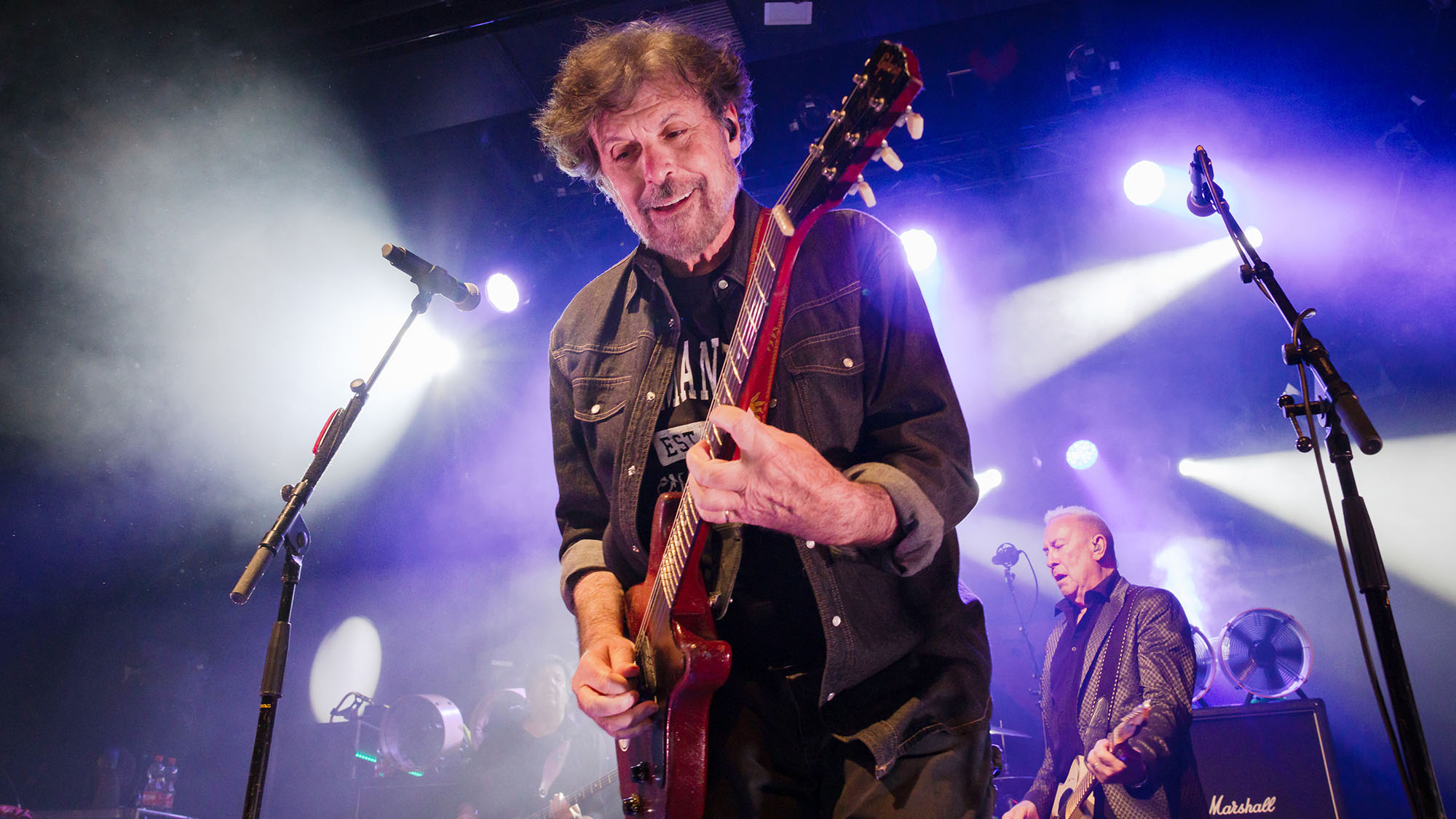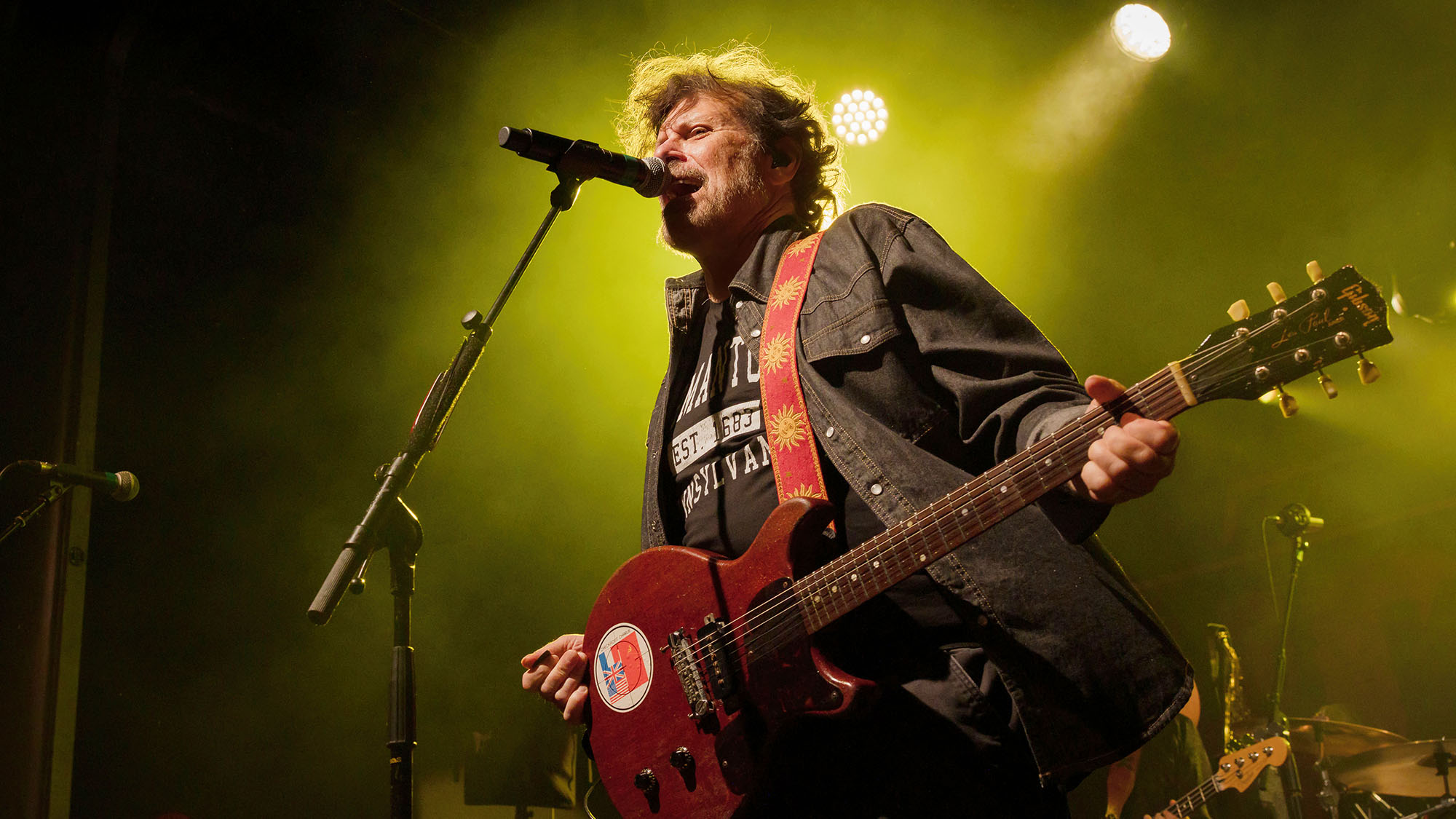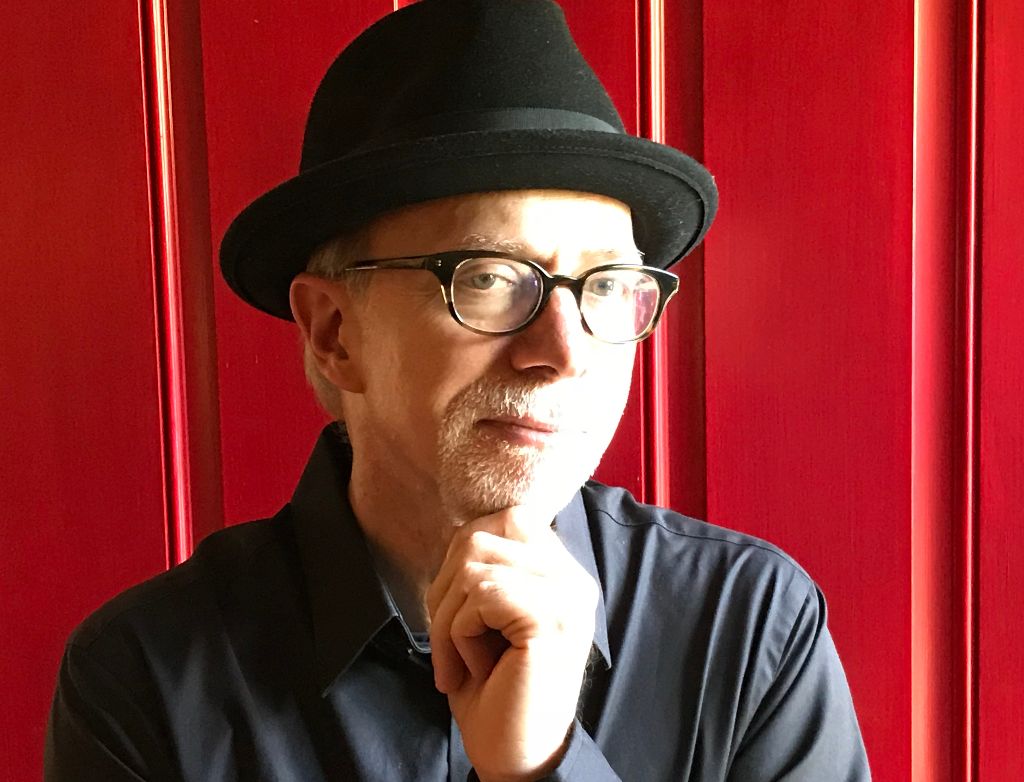“Mick Jagger was moving around like a marionette, responding to every squeak coming out of my guitar”: Eric Bazillian on playing with a Rolling Stone, writing Joan Osborne’s One of Us – and helping Cyndi Lauper find a career-defining hit

Eric Bazillion is nothing if not patient. The Hooters singer-songwriter and guitarist has waited a long while to be featured in Guitar World – 40 years, to be exact – so he was understandably elated to sit down for an interview. “I don’t think I’ve ever been mentioned in any guitar magazine before,” he says. “Finally – here we go!”
While it’s certainly true that the guitar cognoscenti (we include ourselves in that group) has traditionally focused on the tried-and-true legends, there’s still dozens of gifted and notable players – even those who have sold millions of albums – who, for one reason or another, get overlooked. And make no mistake, Bazilian deserves recognition; the man can play. As he points out, “I’ve written and played guitar riffs that people sing.”
He’s quick to mention some examples: “Girls Just Want to Have Fun – I saw the Barbie movie, and all they used was my guitar riff. People hear those first three notes, and they know what the song is. I played that, but I didn’t get credit for myself because I was paid as a session musician.
And there’s One of Us [Bazilian wrote Joan Osborne’s 1995 smash]; people hear that riff and they know the song. I’ve heard from bands that want to cover Hooters songs, and they’ve asked me for help. And We Danced is a bitch. I mean, for me it comes naturally, but it’s not your father’s rhythm guitar part.”
Success didn’t come quickly for Bazilian. In the mid Seventies, the Philadelphia native teamed with singer and keyboardist Rob Hyman and drummer Rick Chertoff to form a progressive rock group called Baby Grand. When Chertoff split to become an A&R executive for Arista Records, he signed the band and produced two albums that failed to sell.
Undaunted, Bazilian and Hyman put together the Hooters, and within a couple of years the hard-driving pop rock outfit ruled the Philly club scene. Local radio stations loved the band, and bookings got bigger and better – the Hooters even opened for the Who at Philadelphia’s JFK Stadium in 1982.
Securing a record deal, however, proved elusive. Then Chertoff, now with Columbia Records, recruited Bazilian and Hyman as core writers and players on Cyndi Lauper’s 1983 debut, She’s So Unusual, and the resulting cavalcade of hits (one of which, Time After Time, was co-written by Hyman) gave the producer enough pull to sign the Hooters.
All the latest guitar news, interviews, lessons, reviews, deals and more, direct to your inbox!
The band’s 1985 Columbia debut, Nervous Night, broke fast with radio and MTV gems like And We Danced, All You Zombies and Day by Day – each one brimming with unbridled energy, hooks a-plenty and Bazilian’s sparky guitar playing.
After years of waiting in the wings for their moment, the Hooters were now double-platinum stars: Rolling Stone named them Best New Band of the Year, and the group was chosen to open the Philadelphia segment of the Live Aid benefit concerts.
“We had screaming girls in Philadelphia in ’83 and ’84, but now it was national,” Bazilian says. “What was really exciting was getting to play the music we made and hearing it on the radio. The rock-star thing was funny because we were already in our late twenties and early thirties. I was 31 when Nervous Night came out.”

The Hooters’ Stateside chart run waned in the late-’80s, but the band saw their stock rise internationally with hits like Satellite and Boys Will Be Boys. When the group announced a hiatus in 1995, Bazilian was already back in the limelight as the main writer and arranger on Joan Osborne’s album Relish, which resulted in multiple Grammy nominations, including Song of the Year for One of Us.
The band’s break only lasted six years; in 2001 they reunited and have remained a steady touring operation ever since.
“If I’ve learned anything about the music business, it’s that there are no made men,” Bazilian says. “Even with success, it never gets easier. For me, I try not to repeat myself creatively, but I also try to stay in my lane, which can make it easy to repeat myself. I mean, there are only so many notes.”
As a guitarist, which players had the most impact on you?
“First it was George and John. I loved John Lennon’s rhythm playing. He’d take short solos sometimes, like on You Can’t Do That – that was like punk. George Harrison’s playing was impeccable. One of my first great accomplishments was learning his solo from Till There Was You.
“Then I got into Keith Richards, but my next true hero was Roger McGuinn. I was 12 years old and I got bar mitzvahed so I could buy a Rickenbacker 12-string. Next came the Holy Trinity – Clapton, Hendrix and Beck. I loved Alvin Lee, too. I saw Ten Years After open for the Jeff Beck Group, and honestly, [Ten Years After] blew them away.”
The next day I was walking to school, and I saw an old man carrying a goldtop Les Paul without a case. Crazy, right? He sold it to me for $150, which is the best $150 I ever spent
When did you start gravitating toward Les Pauls?
“I saw a band called Woody’s Truck Stop in Philadelphia, and the guitar player was a guy named Todd Rundgren. He played a goldtop Les Paul through a Twin, and he was doing blues like Mike Bloomfield. A few days later, I went to see a kid who had just moved nearby, and he had a goldtop Les Paul. I knew I had to get one.
“The next day I was walking to school, and I saw an old man carrying a goldtop Les Paul without a case. Crazy, right? He sold it to me for $150, which is the best $150 I ever spent. I had that guitar for a while, but it was stolen some years later.”
With the Hooters, you played Les Paul Juniors quite a bit.
“It was almost the only guitar on Nervous Night. By that time, I was bouncing between guitars – my ’57 Strat was the Cyndi Lauper guitar, and I had a ’66 Tele that I bought from a friend. But another friend of mine had a Junior. He said, ‘Go to the studio and try it out.’
“The second I plugged it in, it was like, ‘Whoa.’ It was a game changer – the thing sounded great for everything. I could work with the volume and tone controls to make it crunchy enough for rock, but it had enough dynamics to bring out my crazy little voicings.”
I think all the rhythm guitars on Nervous Night were played through a stereo pair of Marshalls
What kind of amps did you pair it with?
“It was either a 1965 Vox AC30 Top Boost or a Marshall 2203 – not the JCM800, but one of the first master volume amps. I think all the rhythm guitars on Nervous Night were played through a stereo pair of Marshalls, a 50-watt and a 100-watt. The solos were through the AC30, except for All You Zombies; on that I played through a Marshall. One take and it sounded right.”
Before the Hooters got signed, you guys were huge in Philly. Was it a pretty competitive scene?
“It was a friendly competition among a lot of bands, but I didn’t feel competitive. Robert Hazard was playing at the same time as us. Our bands were kind of the Beatles and Stones of that scene. They’d open shows for us, and we’d open for them.”
And, of course, Robert Hazard wrote Girls Just Want to Have Fun.
“That’s right. Rick Chertoff was assigned to produce Cyndi Lauper. Rather than do the record with session guys, he wanted a band feel, so he got Rob and me involved. He had a bunch of songs that he thought would be great for Cyndi to cover. She was on board with everything except Girls. She hated it – [imitates Lauper] I will never sing that song!
“We tried it every which way – rocking it out, doing it ska – but she still hated it. One day, I heard Come On Eileen by Dexy’s Midnight Runners, so I started playing the opening lick of Girls with that feel. Cyndi started singing to it, Rob played a keyboard pad on top, and Rick Chertoff’s eyes opened wide. It was like magic. By the end of the day, Cyndi was saying, ‘I’ve always wanted to sing that song!’ She thought it would be very empowering to women.”
Goodness knows you’ve heard that opening riff thousands of times. Do you ever get sick of it?
“It just gets tiring because I’m not getting paid. [Laughs] I’ve come to terms with it for the most part. It’s like I’m taking one to the team. But when I saw Barbie and I heard that riff, it’s like I know what a sync like that is worth. Anyway, what are you gonna do?”
Rob came in and said, ‘That’s a good riff. Let me record that on my Walkman.’ The next day he couldn’t find the tape he’d recorded it on because he labeled it wrong
Tell me about coming up with that riff to Joan Osborne’s One of Us.
“It was sort of the situation as when we did Cyndi’s record. Rick Chertoff was producing and he needed material. The idea was for us to write all the songs together. One day I was working in this crawl space above Rob Hyman’s garage. I picked up his ES-330, and my fingers just went there – I kept playing the riff over and over. Rob came in and said, ‘That’s a good riff. Let me record that on my Walkman.’”
“The next day he couldn’t find the tape he’d recorded it on because he labeled it wrong. It took a while to find it, and by then I’d started playing it in a Chet Atkins finger-picky kind of way. Joan started riffing around with it, but there was no movement toward making a song out of it.
“What happened next was, my girlfriend Sarah – who’s now my wife – she was fascinated by four-track recording, so I decided to show her what my TASCAM could do. I recorded the intro, then a verse and a chorus, then a B section. I laid down all these parts and started to sing lyrics. I kind of sang them like Brad Roberts from Crash Test Dummies. Sarah had fallen asleep, but by the end of all this, I had a song.”
By demonstrating what your four-track could do, you wound up writing one of your biggest hits.
“I had no idea. I totally freestyled the lyrics, but I knew I’d stumbled upon a basic truth and sort of encapsulated my entire worldview. Of course, that doesn’t mean you’re going to have a hit song. I was shocked when, the next day, Rick said to Joan, “Can you sing this?” If he had asked her, ‘Would you like to sing this?’ she might have said no. We did a demo with her singing it, and then we went off to this hunting lodge to cut the album.”
Your guitar solo on the song is pretty raw and crazy.
“It’s pretty shreddy. It’s like me doing a nervous Neil Young. Up till then, I’d played chords through the solo section – I figured I’d overdub something. I clicked on the Rat distortion and let it rip. I tried changing it a few times, but that first solo tells a story.”
What kinds of guitars are you playing nowadays?
“My ’56 goldtop is the Holy Grail. I found another one in L.A. that’s a darkback, and it plays itself. I don’t have a collection – I have a selection – though I do have three 1966 12-string Rickenbackers. I discovered a Finnish luthier – the brand is Vuorensaku – and I saw one of his guitars in a music store in Stockholm.
“I plugged it in, and it was just right. It’s one of the first iconic shapes I’ve seen in decades. It’s not a Strat or a Tele, not a PRS or a Ric; it’s kind of Jaguar-like and Tele-like, with a single P90. He aged it so it looked like a white tabletop from the 1950s. I said, ‘That’s coming home with me.’
“Later on, I had him build me a red one with two humbuckers. That’s my alpha guitar for touring. I do bring out the Les Paul Junior, which I’ll pull out for Zombies or Day by Day, but the main live guitar is the Vuorensaku.”
How about your guitar amps?
“In 2013, I moved over to the dark side. I’m all Kemper, all the time. I got tired of renting Vox amps that sounded like shit. When the Kemper thing came on, I got them to send me a prototype, and the first thing I did was profile my AC30 and Marshall.
“Once I did that, I never looked back. I can play a clean solo loud or a dirty solo loud. I can play crunchy chords without being too loud. I’ve got my time-based effects on it. The front-of-house guy doesn’t even have to touch my channel. I just mix myself. I’m a big fan.”

You cut the solo to All You Zombies in one take, but had you worked it out live beforehand?
“I worked out a lot of solos live, but the Zombies solo was completely spontaneous. I just plugged in and started messing around. I turned the Marshall to two, and that was it. Same thing with Day by Day. That one was just boom!”
Day by Day is such a beautifully composed solo; one would think you’d spent a month figuring it out.
“And you’d think that the guy who played it would be able to come up with another solo as cool as it the next day. But no, Zombies and Day by Day were like I gave birth to them fully formed one day. They came out, they were great, and they remain.”
Around this time, you played a brilliant solo on the single version of Mick Jagger’s Hard Woman.
“That’s right. He thought of us as the team that had done Cyndi’s album. Before he came to the studio, we did a reggae-type demo of the song. Mick came to the Record Plant and listened to what we’d done. He thought it sounded good, but he thought the bass wasn’t right.
“We changed it around after he left, and the next day he came back and said, ‘The keyboard isn’t quite right.’ We finally got it to what he wanted, and when he started to sing it, that’s when it occurred to me, ‘This is Mick Jagger singing.’ I was like, ‘Damn, we’re working with Mick Jagger!’”
Did Mick have any ideas for what he wanted you to play?
“We sort of directed each other. At first, I was going to play an arpeggiated thing, but as I stood there with my Les Paul Junior I thought I should play a blues solo. He was moving around like a marionette responding to every squeak coming out of my guitar. I guess he liked it because in the video he was this computer image playing the solo.”
Joe is a freelance journalist who has, over the past few decades, interviewed hundreds of guitarists for Guitar World, Guitar Player, MusicRadar and Classic Rock. He is also a former editor of Guitar World, contributing writer for Guitar Aficionado and VP of A&R for Island Records. He’s an enthusiastic guitarist, but he’s nowhere near the likes of the people he interviews. Surprisingly, his skills are more suited to the drums. If you need a drummer for your Beatles tribute band, look him up.








